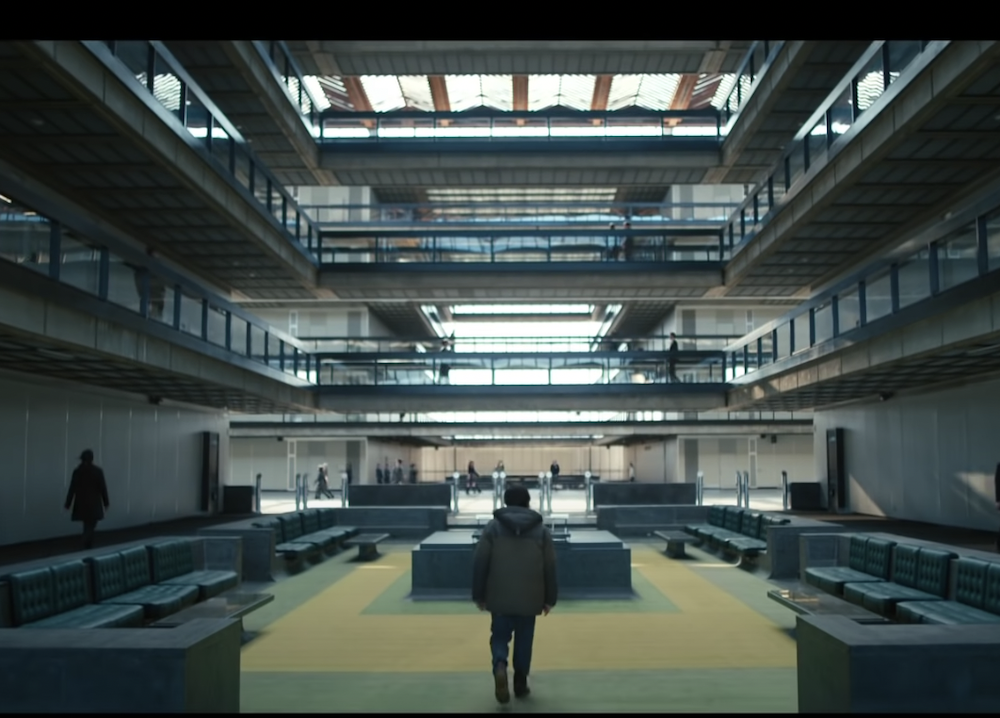Books & Culture
“Severance,” “Severance,” and the Dissociative Demands of Office Labor
A novel and a TV series bearing the same name tell similar stories about capitalism’s walking dead

The design department at the tech company I worked for was suffering from a morale problem. Management saw the writing on the wall; our big happy work family was on the verge of a smashup. One afternoon, we received an email from the director informing us that the company was excited to offer a new paid benefit: reimbursement for an online personality test. A set of simple questions would teach us how we could best thrive in adversity and give us empathy for each other’s unique challenges. The email included a link to a website and concluded with a grinning emoji.
We’d ushered our whole selves into work and discovered that those selves were lonely, sad, frustrated, and furious.
But the website offered two versions of the test, one for “business” use and one “personal,” and our boss hadn’t mentioned which was sanctioned. My colleagues and I spent a good 15 minutes of company work time debating between them, finally deciding that the personal test would offer the broadest insights—it was twice as long—and weren’t we the same people regardless of physical location? Wherever you go, there you are, we figured. But answering those questions and receiving our personalized diagnoses turned out to be more than a team-bonding exercise. It was an awakening. As we read our results out loud to each other, we realized that we had opened the portal between home and office, transgressing the boundaries that kept us focused and manageable. We’d ushered our whole selves into work and discovered that those selves were lonely, sad, frustrated, and furious. It was uncomfortable, but we couldn’t talk about anything else. Over the next year, all but one of us left the company, more than a few in rage or in tears. There are infinite reasons to leave a job, but I remember the collective turning point as the day my coworkers and I stepped out of our friendly work personas and into our full humanity. We could never go back to a productively compartmentalized day working for that company again.
If a personality test is a nudge that collapses the personal and professional, a polarizing national election is a powerful stirring, and two and a half years of a global pandemic is an ear-splitting, earth-shattering alarm. Two beautifully crafted pieces of narrative art from different moments of this tumultuous historical moment capture both the horror and the haunting of contemporary work culture: the 2022 hit Apple TV+ show Severance and the unsettlingly prescient (and unrelated) 2018 novel of the same name. Through the fictional lens of extreme speculative scenarios—that somehow become more plausible by the month—both narratives illustrate the tempting lure of productive white-collar distraction in a chaotic world, the price of the dehumanizing dissociation that it demands, and the recognition that finding deep meaning and purpose in our relationships with each other can free us from a life lived half-asleep.
In Severance, a novel by Ling Ma published a year before COVID-19 emerged, Candace Chen is an employee at NYC-based publishing conglomerate Spectra. She goes through the motions of office life even after a deadly pandemic descends. Candace first discovered work to be a source of comfort when her mother became ill with Alzheimer’s (“It took my mind off things”), and after the death of her parents and one numbed-out summer in New York, she returns to office life to find meaning—or at least something to do every day. As the news of “Shen Fever” trickles into the world around Candace, she holds fast to her job as a way to make sense of her existence, becoming a kind of corporate automaton: the last worker in the office, if not the entire city. By day she performs her now-meaningless tasks, and by night she walks the streets taking photos of the new world for her photo blog, aptly titled “NY Ghost.” Everyone Candace encounters is either fleeing for safety or suspicious as to why she’s content to perform the dance of employment long after the music has stopped. But to Candace, the office is safe, the only place in her life that has been a reliable source of emotional regulation and accomplishment. Candace is a millennial and a first-generation immigrant through and through. For her, like so many born into this era of political and social turmoil, work is “its own consolation.”
Shen Fever turns the infected into the walking dead of capitalism: wordless creatures doomed to perform the same routines over and over.
Candace’s daily agenda, as she describes it over and over throughout the novel, is all-too-relatable to anyone who has faced down a sad desk salad: “I got up. I went to work in the morning. I went home in the evening. I repeated the routine.” When she decides to break things off with her overly idealistic boyfriend: “I emptied myself, lost myself in the work. I got up. I went to work in the morning. I went home in the evening. I repeated the routine.” When she finds out she’s unexpectedly pregnant from that same ex: “I didn’t know what to do, so I pushed it to the farthest corner of my mind. I went to sleep. Then I got up. I went to work in the morning. I went home in the evening. I repeated the routine.” If you haven’t already guessed, Severance is a zombie story.
Shen Fever turns the infected into the walking dead of capitalism: wordless creatures doomed to perform the same routines over and over. They apply face creams, set dinner tables, try on outfits, and drive cabs ceaselessly until their bodies waste away from starvation, their to-do list ambitions unrealized. But in Severance, author Ling Ma questions whether Candace is sick too, trapped in a lonely and dissociative trance that she mistakes for relief. The comparison is not lost on the character, either, but she can’t quite change her habits on her own. It’s Candace’s unborn child and the future that she starts to imagine for them both that gives Candace the determination to live a full life of her own choosing. As her pregnancy progresses, Candace feels the baby flutter inside of her, gives her a name, and imagines a fulfilling relationship outside of the transactional exchange of labor for survival. As Candace leaves the office for the last time, she notices a billboard she hadn’t before: “Life is knowing what you live for.” She has finally found a love worth staying awake to experience. In Severance, the comfort work offers is a numbing agent, and while the world is scarier without the drug of productive routine, it may also be more full of hope.
The 2022 TV series Severance is a zombie tale too, with a “body horror” twist. The show is named for the brain surgery required to work at a mysterious tech company called Lumon—like Severance’s Spectra, it’s a word that summons an ironic sense of bright possibility, “Arbeit Macht Frei” for the corporate prisoner. The severance procedure segregates employees’ memories by location, effectively splitting employees into entirely different people when they’re at home and at work. Watching the show, I was transported back to my former design department, my finger hovering over the Enneagram “buy” button. If my colleagues and I had been severed, there would’ve been no question as to which test to take: in the office, we would’ve been “innies,” with no relationship to our homebound “outies.” The company would have surely been more satisfied with the results of our tests, and I couldn’t help but imagine that we employees might have been grateful for the clarity.
The premise of Severance is not that a nefarious corporation turns people into zombies. It’s that we choose to undead ourselves as a treat. Along with a fat paycheck, dissociation is Lumon’s enticing sales pitch to potential employees: never experience the drudgery of labor or the sting of emotions during work hours again. The innies of Severance don’t know why their outies have chosen a segregated life, but as viewers we learn the motivation of one worker, Mark S, who became unable to perform his teaching job after his wife’s sudden death and finds a path back to productivity through Lumon. By pressing pause on his pain for eight hours a day, Mark can make a living again with the added benefit of a spa day for the brain. And honestly, it doesn’t sound so bad to sleepwalk through a job for a lucrative fee. Writer Emily Gould joked on Twitter that she’d “totally get severed if it was PT, like, 15 hours a week.”
The unavoidable truth is that someone still has to live through the work day; labor is never free.
But the unavoidable truth is that someone still has to live through the work day; labor is never free. In Severance, innies are the enslaved undead, wandering Lumon’s windowless purgatory, muttering the company’s mantras, and moving numbers around on a screen to earn woven finger traps and melon parties. One severed worker, Helly R—who turns out to be a dissociated shell of a Lumon executive—goes so far as to attempt suicide. But after learning of Helly’s pain, rather than allowing her to quit (a euthanasia of sorts), Helly’s outie records a cruel video message condemning her to continue existing in a body that doesn’t belong to her. “You are not a person,” the woman who looks exactly like Helly R tells her as an explanation.
The sheer panic of realizing you don’t have bodily autonomy resonates well beyond office walls in 2022. As state governments and the Supreme Court continue to make clear that women and trans people, in particular, are property of the state, their bodies to be legislated and controlled against the will of the individuals who inhabit them, it has become harder and harder for workers to ignore the terrifying world and do our little Zooms to make enough money to pay for the rising cost of rent, healthcare, and other essentials to human life. Yet it is more and more urgent to corporations that we close our eyes in the service of productivity, hitting quotas and yielding profits before the economy tips into recession. Companies and business leaders are pushing workers back into offices, writing op-eds about the value of the physical workplace and crafting new policies that chain employees to their desks. Other companies are trying out the carrot method: throwing parties, hosting concerts, and handing out high-end swag to those who can retrace the steps of their commute after years without one. But these tactics aren’t new. In Severance, Lumon’s genius is to contain the dread of the people, not stamp it out. In real life, some corporations have attempted to do something similar many times over.
Before the pandemic, I took far more than that one personality test at different jobs, memorized corporate values, crafted reusable fun facts for endless ice breakers, and escaped many rooms with my colleagues in order to reshape myself into an appropriate work character. It’s surprising how easy dissociation becomes when it’s aided by physical compartmentalization. I was encouraged to leave my mood at the door when I swiped in with my smiling badge. The tech companies I worked for decorated their offices with optimistic flourish, giving me far-reaching views of the city and wearable proof of belonging—pins, stickers, t-shirts, even shoes. But once the pandemic struck and we were confined to our homes, non-surgical severance became harder to pull off. All of a sudden, my work self and home self were shoved into the same space—the bedroom that served as office, gym, preschool, writing studio, and cafeteria—with no breathing room between parenting, meetings, and an eked out creative life. There was no corporate bus to act as a decompression chamber between worlds, no work uniform to armor myself with for professional battle; I only put on shoes to walk the dog. Moment to moment, I felt confused about my priorities. I was stunned to hear my own voice telling my daughter no, I couldn’t eat lunch with her because I had to discuss the optimal size of boxes on a screen. In meeting after meeting, I clicked “camera-off” to hide tears collecting in my eyes, threatening to ruin the curated tone. I stopped showing up for virtual team-building games, but fell sick with guilt when my absence was noted. On the hardest days, I even told coworkers that none of what we made mattered. The fact is, maybe it did matter and maybe it does, but not to me anymore.
In the show Severance, “reintegration” is possible but excruciating, sending employees into an existential tailspin. In my life, the collapsing of worlds felt like I was losing my mind, like my carefully assembled illusion of control was shattering over and over as I spreadsheeted my way through unprecedented times. I missed the peace of dissociation, but I was incapable of pulling myself apart to get the job done any longer. I physically couldn’t smile when I was angry, I couldn’t form the word yes when I meant no. My exhaustion and rage bled through the work day, staining everything; all I had left for my daughter was excuses. Because I was lucky enough to have the support system to do it, I quit my corporate job and reclaimed my ambitions for myself, my creative work, and my family. I needed to forge a different kind of relationship to work. Like Candace Chen escaping New York in Severance the novel, I didn’t know what was next but I knew I couldn’t go back.
The question of how much of ourselves we must give up to work is an essential one.
The tragedy and possibility of a zombie story is that there is no single villain. In the novel, Candace’s sometime-mentor sometime-captor Bob points out the rules of the undead narrative. “One zombie can easily be killed,” he tells her, “but a hundred zombies is another issue. Only amassed do they really pose a threat.” Bob is right. We may all be work zombies, lured and forced into semi-consciousness by the brutal financial realities of our age and economic system, but it is critical to remember that we are all in this together. As we’ve seen in the exhilarating recent unionization movements within industries like publishing and tech, the true power of labor is built by the collective. And I’m certainly not the only one calling it quits on my work persona. When record numbers of Americans are leaving their jobs and rethinking the sacrifices required to make a living in this country, the question of how much of ourselves we must give up to work is an essential one. Perhaps the greatest virtue of both Severances is that they externalize a too-often internal debate, capturing the poetry and violence in the struggle towards both inner and outer unity within a society that wants to split us apart. And both narratives suggest that dissociation is—at least in part—a trick of self-hypnosis that we can choose to shake ourselves out of. If we can vow to stay present together in the midst of true disaster, then maybe there is hope for the future. Like Ma’s novel, the first season of Severance ends with a cliffhanger. Mark S, Helly R, and the other innies hatch a plan to wake themselves up on the outside, inhabiting their outies’ forms long enough to fumble towards the truth. The show ends as they are each pushing against the foreignness of the real world to claim their right to self-determination. Will the innies survive reintegration to take down Lumon and the dead-eyed oligarchs controlling the rest of their world? Luckily, the show has been renewed for a second season so we may find out soon. But here in the real world right now, we can learn from the innies’ bravery and Candace’s determination. No matter how uncomfortable change may seem at first, we each have the power to shake ourselves out of old and mechanical patterns, connect with the people and ideas that deserve our time and effort, and finally make work work for us—not the other way around.









